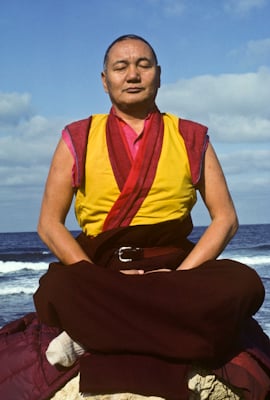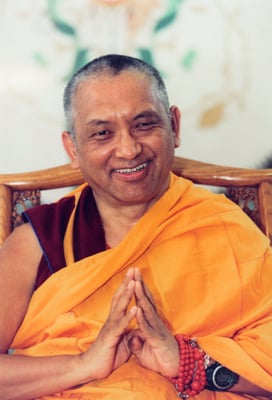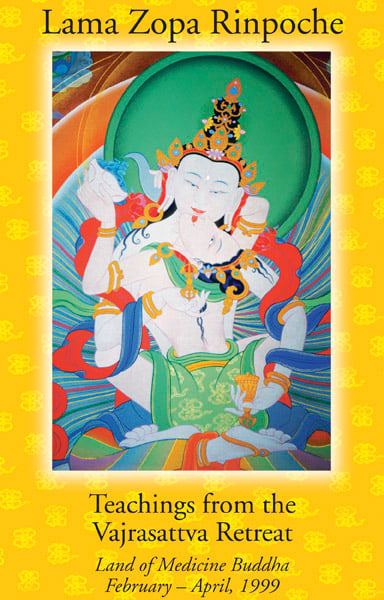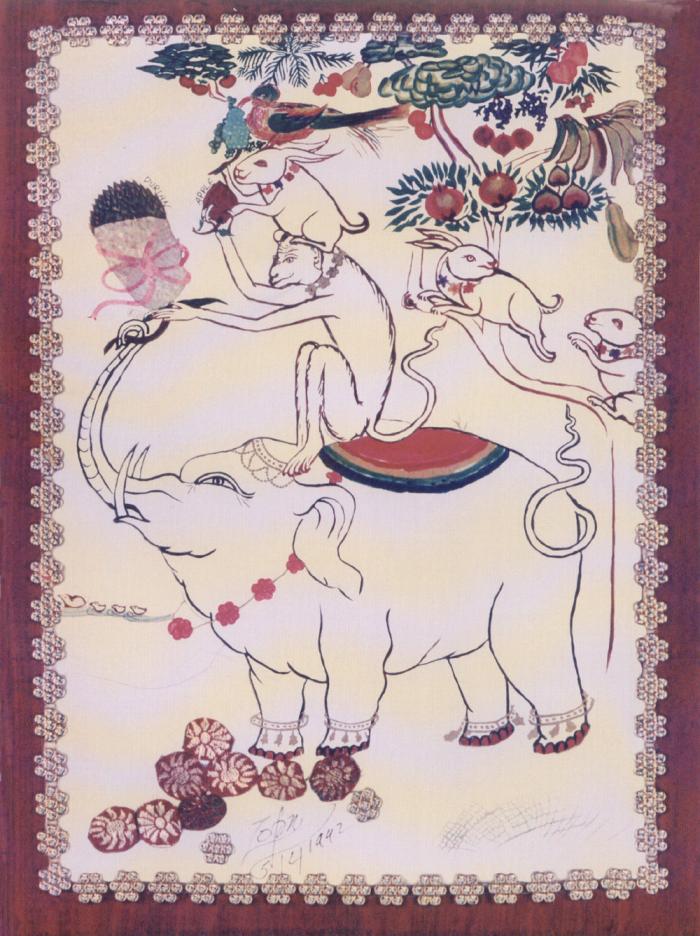Happy 2017 to you all. We are so grateful to all of you who made our Annual Year End Appeal a great success! We reached our $50,000 goal and are ready for another amazing year of bringing the precious Dharma teachings to the world.
New Multimedia Title
We are pleased to present our newest multimedia title Giving and Taking on the Breath by Lama Yeshe. This is the latest in the multimedia series of teachings from Freedom Through Understanding, a book based on teachings given by Lama Yeshe and Lama Zopa Rinpoche in UK in September 1975.
In this title Lama guides us through the Mahayana practice of tonglen where we give all our causes of happiness to others and bring all their causes of suffering into our heart. Lama impresses upon us how this practice helps us flush out our egotistical self-cherishing mind while simultaneously planting the seeds in our mind that will grow into our liberation and enlightenment.
What's New On Our Website
 We have just posted the lightly edited transcript of a Mahamudra Q & A With Lama Yeshe. This question and answer session was part of the First Enlightened Experience Celebration, hosted by International Mahayana Institute and was held at the Bhagsu Hotel in Dharamsala, India on March 17, 1982. In this session Lama responds to student questions about the practice of mahamudra after His Holiness the Dalai Lama's teachings on the topic. This is the transcript of the recently posted video of the talk that we published to our YouTube channel last month.
We have just posted the lightly edited transcript of a Mahamudra Q & A With Lama Yeshe. This question and answer session was part of the First Enlightened Experience Celebration, hosted by International Mahayana Institute and was held at the Bhagsu Hotel in Dharamsala, India on March 17, 1982. In this session Lama responds to student questions about the practice of mahamudra after His Holiness the Dalai Lama's teachings on the topic. This is the transcript of the recently posted video of the talk that we published to our YouTube channel last month.
We have also just posted updates to the 1971 chapter from the forthcoming biography Big Love: The Life and Teachings of Lama Yeshe. Read accounts from students attending the first Kopan Lamrim course that year and view amazing archival images. You can read excerpts from many more chapters on our Big Love Blog. We've included the latest addition to the blog as our featured e-letter teaching below.
There are several new advices added to Rinpoche's Online Advice Book this month, including:
- The Quick Path to Enlightenment: This advice was for a student who had cancer and was being cared for by a relative.
- Renounce the Ego: The shortcomings of the self-cherishing thought and the benefits of cherishing others.
- Experience Obstacles for All Sentient Beings: Advice given to a student who asked about the practice of offering water bowls.
- The Suffering of Samsara: A monk asked whether it was beneficial to go to Myanmar to meditate for three months.
As always, you can see all the newly-posted advices on our View and Search Advice Book page.
New Video on YouTube
LYWA is very happy to make available this video of Lama Zopa Rinpoche's teachings from Mongolia in 2002 on emptiness and impermanence titled Remembering Impermanence & Understanding What is True Dharma. Originally published by Dharma Vision, the video is beautifully edited and fully subtitled and was produced by Christina Lundberg.
Remembering Impermanence and Understanding What Is True Dharma is a concise explanation on how reflecting on impermanence supports spiritual progress and the different levels of motivation that transform daily activity into authentic Dharma. Rinpoche also discusses the nature of samsara, the definition and quality of the mind of renunciation, and gives commentary on a short but powerful lamrim prayer suitable for any practitioner.
This Month's Podcast: The Benefits of the Enemy
 “So this time maybe mention little bit about reincarnation, going back from where it started, back to the beginning of the life…”
“So this time maybe mention little bit about reincarnation, going back from where it started, back to the beginning of the life…”
This month's podcast is an excerpt from Lama Zopa Rinpoche's teachings from the 29th annual Kopan Lamrim Course from 1996. The title of this excerpt is Benefits of the Enemy. This podcast presents Rinpoche’s teachings on patience, bodhicitta, and reincarnation, and includes a question and answer session. You can follow along with the unedited transcript on our website, and listen to more excerpts from this same course.
Over the years we have posted the transcripts of nearly 30 Kopan Lamrim courses, ranging from the third course in 1972, on up through 2010, which you can view and search on our website. Some of the courses have the audio recordings posted as well. And, last year we published a 4-volume ebook series of the teachings from the 24th Kopan course in 1991. These Kopan Lamrim course transcripts are a treasure-trove of teachings from Rinpoche on countless lamrim topics along with numerous anecdotes and stories from Rinpoche's life.
TeachingS From the Vajrasattva Retreat
 We recently received a couple of boxes of Teachings From the Vajrasattva Retreat, a classic LYWA title that we published in 2000. This book is an edited transcript of Lama Zopa Rinpoche’s teachings at a three-month Vajrasattva retreat held at Land of Medicine Buddha, Soquel, California, from February 1 to April 30, 1999. We have been sold out here in the US for many years, and are delighted to have a couple dozen copies back in stock. If you are interested in purchasing one of these volumes, please visit our website.
We recently received a couple of boxes of Teachings From the Vajrasattva Retreat, a classic LYWA title that we published in 2000. This book is an edited transcript of Lama Zopa Rinpoche’s teachings at a three-month Vajrasattva retreat held at Land of Medicine Buddha, Soquel, California, from February 1 to April 30, 1999. We have been sold out here in the US for many years, and are delighted to have a couple dozen copies back in stock. If you are interested in purchasing one of these volumes, please visit our website.
We leave you with the latest post from our Big Love Blog. Thank you again for all your incredible support, as we continue in our mission together to bring peace to the world.
Much love,
Nick Ribush
This Month's Teaching: Our mind is like the surface on which we make a drawing
 From the 1981 chapter of Big Love: Public and Private Time:
From the 1981 chapter of Big Love: Public and Private Time:
That evening Lama Yeshe led a puja at Tara House. Two days later he gave a weekend course to eighty people on Nagarjuna’s Letter to a King. This was a letter written by one of Buddhism’s most highly realized scholar-practitioners to a king in India nearly 2,000 years ago. During the teaching Scott Brusso picked random questions from the audience out of a basket. “While he was answering one question, I was picking out the next,” said Scott. “I read it then decided it wasn’t very good. So I put it back and went to choose another. This was all quite invisible to everyone else and done below the lip of the basket. But Lama stopped in mid-sentence, turned to me and said, ‘Don’t discriminate! Give it to me now—that one!’”
From Lama Yeshe’s teachings on Nagarjuna’s Letter to a King in Melbourne, 1981:
Nagarjuna explains how we control our anger by actualizing the paramita (perfection) of patience. He also says how it is very important in the first place that we not open up the door of any situation that may lead to anger. Why? Because the minute that we generate anger energy, its characteristic is to react again and again and again, thereby leading us into a miserable life. Simple, isn’t it?! So, on the other hand, Nagarjuna quotes Shakyamuni Buddha himself, who said in the sutras that if one abandons anger, there’s no need to worry about entering any situation; there is no need to worry about having a miserable life. Shakyamuni promised, and Nagarjuna quotes from Shakyamuni’s teaching. That’s interesting for me. At this particular place Nagarjuna says, “Shakyamuni says that if you don’t have anger, you don’t have to worry about entering any miserable life situation during this life or your next several lifetimes.” Interesting, isn’t it? I feel that this is really very important. Anger is the worst karma to have. Not only does it destroy your good-quality peaceful joyful life right now, but it also destroys your good quality next life as well. There is a reason that we are born in an unpleasant place, isn’t there? Due to causation, the mental energy of anger irritates and results in our physical situation, our physical bodies. Buddhists believe that everything has a reason, that everything has a history and an evolution.
So for us it is very important to control our anger as much as possible. Anger is our worst enemy, you know, our worst enemy. I think that anger destroys all the good qualities of our human dignity. For this reason, it is very important to control it. For example, one moment of anger can destroy a good friendship of twenty or thirty years, a long-time relationship in which the friends shared everything. Anger can destroy this in just a moment. The angry mind has no appreciation for any of this. Can you imagine? It’s unbelievable, but even the shortest moment of anger can destroy the collected energy of twenty or thirty years of friendship and lead to misery. All these things are part of human experience, aren’t they? Therefore, since we like to be happy, Buddhism places much emphasis on the importance of controlling anger, so we can be happy. By controlling our anger we’ll receive only a human rebirth and we’ll go from happiness to happiness, from bliss to bliss. I think this is very sensible understanding.
Patience, on the other hand, is the opposite of anger. To be patient is to not be irritated or angry. But in order to be patient, one must first understand the anger situation. In one of Shantideva’s verses, he writes, “If somebody beats me and punches me and then I become angry and punch him back…” He says that this is nonsense. “By reacting with anger, does the pain of the punch you already received disappear? Or not?” Shantideva sort of scientifically analyzes the situation. Maybe your nose is already broken. By reacting in anger, your nose doesn’t get fixed, does it?! In just this way you can analyze all the details of the situation. And because of this kind of analysis, Buddhist anger control is unique.
Now I’ve been talking about control, controlling our anger. But is this the correct word? Sometimes I have a problem with language, with finding just the right word in English. Here, control does not mean you repress your anger. Control refers to a way to understand, a way to express.
In Buddhism, it is highly advised that we not manifest anger physically or verbally. Because by the time it manifests it is already super strong, super intense. So before we express our anger verbally or physically, somehow we need to stand up and control it. Somehow we need to digest or abandon the emotion of anger, through meditation, through analytical wisdom, through whatever method we can use.
Nagarjuna explains how to deal with situations in which strong emotions arise. Each human being has the aspect of a different element, which manifests as a way of thinking, a way of perceiving, a kind of mentality. There are three basic types. Our mind is like the surface on which we make a drawing. Sometimes the mind where we draw an object is like water, sometimes it is like earth, and sometimes it is like rock or stone. Okay. So when this kind of superstition or delusion arises in the mind, sometimes it’s like drawing on water, isn’t it? It arises suddenly, and then phew! It disappears almost immediately. Sometimes it’s like drawing in earth; the delusion only disappears slowly, slowly. But sometimes, the impression left on the mind is like a drawing on rock or on concrete. In that case, it seems to stay; it seems like it is always there, doesn’t it? In the instance of drawing on the water, that kind of mind is unstable. Therefore, whatever deluded minds or emotions arise—anger or whatever—as much as possible we should try to make this like drawing on water. Okay? This is what Nagarjuna said. But when the profound wisdom that touches reality arises in the mind, you should make this like drawing on stone. You should develop this kind of stability so that you can become liberated. That’s very important.
Excerpted from Big Love: The Life and Teachings of Lama Yeshe by Adele Hulse. Forthcoming from Lama Yeshe Wisdom Archive in 2017.































